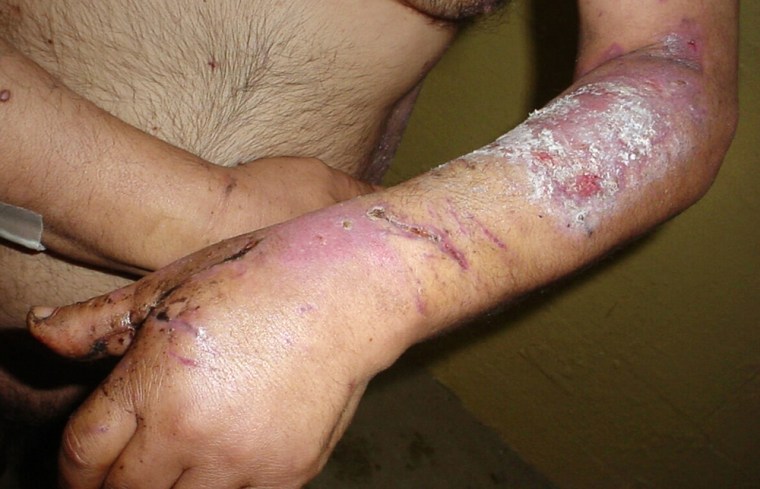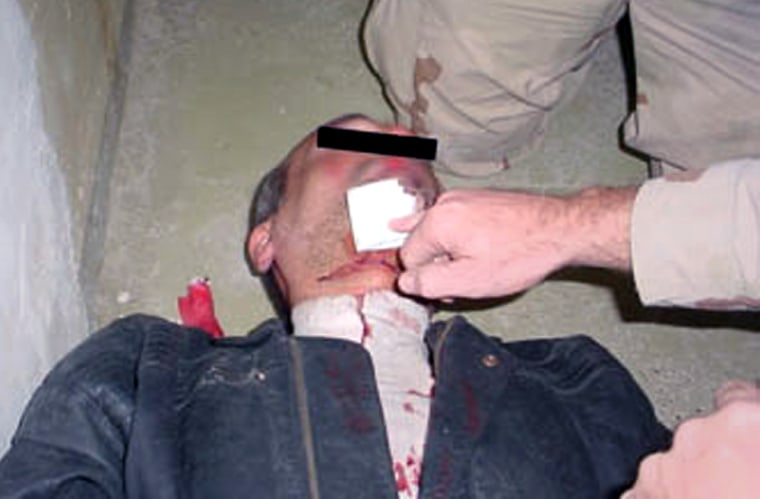Newly released images of naked prisoners, some bloodied and lying on the floor, threatened to revive public anger over abuse by U.S. guards at Abu Ghraib prison at a time when tensions with the West are already running high in the Middle East.
The images were taken about the same time as the earlier photos three years ago that triggered a worldwide scandal and led to military trials and prison sentences for several lower-ranking American soldiers.
But many of the pictures broadcast for the first time Wednesday by Australia’s Special Broadcasting Service, including some that appear to show corpses, were more graphic than those previously published. One of the video clips depicted a group of naked men with bags over their heads standing together and masturbating. The network said the men were forced to participate.
Some key Iraqi officials urged their countrymen to react calmly since the pictures were old and the offenders had been punished.
More than 1,000 items
New images appeared Thursday on the Web site Salon.com, which said it had obtained more than 1,000 photographs, videos and supporting documents that were part of the Army Criminal Investigation Command investigation of the case.
The 18 new pictures posted on the site included an image of an Iraqi strapped face down on a bunk bed with women’s underwear over his head, blood smears indicating a body had been dragged along the floor and a prisoner apparently sodomizing himself with an object.
Salon.com said the material was provided by an unidentified person “who spent time at Abu Ghraib as a uniformed member of the military and is familiar with the CID investigation.”
The Web site said the material was believed to include all photographs published after the scandal broke in April 2004, as well as the photographs and videos published Wednesday by the Special Broadcasting Service.

Salon.com said the material includes a June 6, 2004, CID report that refers to 1,325 images of detainee abuse, 94 video files of abuse as well as images of adult pornography, suspected dead Iraqi detainees, soldiers in simulated sexual acts, “a soldier with a swastika drawn between his eyes,” dogs used in abuse of detainees and “125 images of questionable acts.”
Iraq’s prime minister on Thursday condemned the new images of abuse, but said those responsible had already been punished.
“The Iraqi government condemns the torture practices revealed through the recent pictures that show Iraqi prisoners being tortured,” Prime Minister Ibrahim al-Jaafari’s office said in a statement. It said, however, the Iraqi government welcomed the U.S. denunciation of the pictures.
Anti-Western protests over cartoons
In the Middle East, where there have been widespread anti-Western protests recently over caricatures of the Prophet Muhammad, reaction has been muted.
Al-Jazeera and Al-Arabiya TV aired some of the Australian station’s footage but refrained from using the most shocking and sexually explicit images. CNN also broadcast excerpts.
The newspapers Al-Hayat and Al-Sharq Al-Awsat ran some images on their front pages Thursday, as did newspapers in Lebanon.
The Egyptian opposition newspaper Al-Wafd ran the images on its front page with the headline, “New scandals from the angels of punishment of the American occupation in Iraq.”
But government papers kept the photos on inside pages, with a brief mention on the front page at most.
Iraq’s acting human rights minister, Nermine Othman, said she was “horrified” by the pictures and would study whether any action could be taken against those responsible, even though some offenders have been imprisoned.
“There will be two kinds of reactions from Iraqis,” she told The Associated Press. “One will be anger and others will feel sorry that they (SBS) didn’t give them to the Iraqi government to investigate. Why use them? Why show them? We have had enough suffering and we don’t want any more.”
Pentagon condemns release of photos
Pentagon spokesman Bryan Whitman said the Defense Department believed the release of additional images of prisoner abuse was harmful and “could only further inflame and possibly incite unnecessary violence in the world.”
Whitman said he did not know whether the photos and video clips were among images the Pentagon has been withholding from public release since 2004.
But another defense official said Army officials had reviewed the photographs posted on the Sydney Morning Herald’s Web site and matched them to images that were among those turned over to military authorities in 2004 by a U.S. soldier.
The official, who spoke on condition of anonymity because he was not authorized to address the matter publicly, said the photos contained no new information about abuse.
Although the Abu Ghraib case was exhaustively reported here years ago, the new images could revive the issue of treatment of Iraqis by U.S.-led occupation forces, who face the ever-present threat of death or serious injury at the hands of insurgents.
Ties severed over U.K. abuse video
This week’s release of video showing British troops beating Iraqi youths during a violent 2004 protest in the southern city of Amarah prompted the Basra provincial administration to severe ties with British authorities.
Members of Shiite political groups opposed to the U.S.-led coalition appeared to have engineered that move. They were apparently seeking to exploit public sensitivities after attempts by the British to crack down on Shiite militias.
The new Abu Ghraib pictures emerged as the United States is trying to reach out to the disaffected Sunni Arab community, the backbone of the insurgency, in hopes of encouraging Sunni insurgents to lay down their arms and join the political process.
Most of those who suffered abuse at Abu Ghraib were believed to have been Sunni Arabs. Sunni leaders have also alleged mistreatment by Shiite-led Iraqi government security forces, a development that has sharpened sectarian tensions.
Mindful of the risks, some key Iraqi officials either avoided comment or sought to play down the images, noting the Americans had already punished Abu Ghraib guards.
Presidential security adviser Lt. Gen. Wafiq al-Samaraei called the abuse “unjustifiable” but added that it was important to remember that the actions occurred more than two years ago, offenders had been punished and rules on treatment of prisoners were tightened.
“The effect of something that happened two years ago is not the same as if it were repeated, for example, three months ago,” he said.
The Australian station refused to say how it obtained the images, and their authenticity could not be verified independently.
9 Americans convicted
However, they were consistent with earlier photographs of abuse by American soldiers at Abu Ghraib. Nine American soldiers — all low-ranking reservists — were convicted in the abuse and sentenced to terms ranging from discharge from the Army to 10 years imprisonment.
Whitman said more than 25 people have been held accountable for criminal acts and “other failures” at Abu Ghraib.
The network, which aired the pictures on its “Dateline” program, did not identify anyone in the images. However, several photos appear to show former Spc. Charles Graner Jr., who is serving a 10-year prison term for his role in the scandal.
SBS said the images it showed were among photographs the American Civil Liberties Union was trying to obtain from the U.S. government under a Freedom of Information request.
The ACLU said it did not know how the images broadcast by SBS corresponded to its litigation. But it called on the U.S. government to investigate whether the abuse was systematic instead of blaming it on a few individuals.
